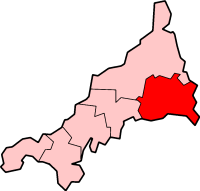| Caradon District | |
|---|---|
 | |
| Population | |
| • 1973 | 58,520 [1] |
| • 2001 | 79,647 [2] |
| History | |
| • Origin |
|
| • Created | 1 April 1974 |
| • Abolished | 1 April 2009 |
| • Succeeded by | Cornwall unitary authority |
| Status | District |
| ONS code | 15UB |
| Government | District council |
| • HQ | Liskeard |
 | |
| Subdivisions | |
| • Type | Civil parishes |
Caradon was a local government district in Cornwall, England, United Kingdom. It contained five towns: Callington, Liskeard, Looe, Saltash and Torpoint, and over 80 villages and hamlets within 41 civil parishes. Its District Council was based in Liskeard 50°27′11″N4°27′54″W / 50.453°N 4.465°W .
Contents
The district was formed on 1 April 1974 under the Local Government Act 1972, by the merger of the boroughs of Liskeard and Saltash with the urban districts of Looe and Torpoint, along with Liskeard Rural District and St Germans Rural District.

The district was named after Caradon Hill, the principal landmark of the area, and formerly the site of important copper mines. The district was abolished as part of the 2009 structural changes to local government in England on 1 April.






